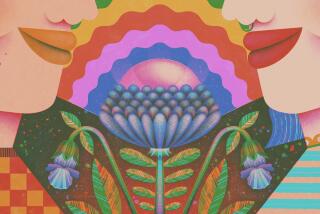Frankincense, Myrrh Making a Comeback as Oman Revives Its Perfume Industry
- Share via
MUSCAT, Oman — The biblical fragrance of frankincense is on the market again as Oman revives an ancient perfume industry that flourished 3,000 years ago.
The Oman Perfumery is opening new markets in the United States and Europe for Amouage (Arabic for “waves”), a perfume based on frankincense and myrrh.
At about $375 an ounce, Amouage may be the world’s most expensive perfume.
Frankincense, the gum from a desert shrub called Boswellia carterii, was prized in ancient times as a drug, a medicine and an aromatic.
Legend had it that frankincense trees were guarded by winged serpents and that only an elite tribe could tap the bark for the precious resin.
Myrrh, the resin of a plant that looks like a small cactus without the prickles, was once harvested in Dhofar province where, legend has it, the three kings gathered before following the star of Bethlehem to pay homage to Jesus.
Amouage was developed in 1984 by the government-supported perfumery, also known as the House of Amouage, and has been one of Oman’s major successes in its effort to diversify the country’s oil-based economy following the slump in oil prices.
“Amouage is the Rolls-Royce of perfumes,” said Khalifa Mukheini, House of Amouage’s marketing executive. “It was created for people who don’t have to ask the price.”
It took four years for master perfumer Guy Robert, a Frenchman, to develop the fragrance. He came up with three varieties that were tested on men and women in the West and around the Middle East.
A winning bouquet emerged, and the formula is a closely guarded secret.
What is known is that Amouage contains more than 100 natural ingredients, including Dhofari frankincense and myrrh, Omani lime and Omani rose found on the 6,000-foot-high slopes of Green Mountain.
Added to these are such exotic items as the honey-scented tuberose, jasmine, blue chamomile, orris, vanilla, patchouli, sandalwood, geranium and musk.
The fragrance for men is decidedly musky. The women’s is more floral.
Amouage has 50 major outlets in New York, London, Paris, Geneva and the Persian Gulf, and despite its price, it appears to have a growing clientele.
It is sold in sterling silver flasks with 24-carat gold inlays. But it also is sold in cellophane sachets at airport shops.
The perfumery, on the outskirts of Muscat, Oman’s capital, declined to disclose dollar figures but said sales last year rose by 16% over 1986.
Officials anticipate another rise this year with a new marketing drive into other parts of the United States, including Beverly Hills.
“We’ll soon be marketing a new brand of the exotic Arabian perfume, to be sold in French-made crystal and at about 35% the price of the Amouage in the silver flasks,” Mukheini said.
The government of Oman, a sultanate the size of Kansas on the southeastern tip of the Arabian peninsula, is giving guidance on harvesting to frankincense growers and helping them find markets.
There are no statistics on current frankincense production, but there are an estimated 400,000 to 500,000 frankincense trees in Dhofar.
Three thousand years ago, the most sought after frankincense in the world came from Dhofar, on the edge of the desolate Empty Quarter.
It was carried by camel train over the great caravan routes across the Hadramut desert to Babylon, Egypt, Greece and Rome or shipped in dhows to India and the Orient.
About 3,000 tons are said to have been shipped annually during the time of Christ.
The Greek philosopher Herodotus wrote that 2 1/2 tons of frankincense were burned every year in the Temple of Baal in Babylon, now part of modern Iraq.
More to Read
Sign up for Essential California
The most important California stories and recommendations in your inbox every morning.
You may occasionally receive promotional content from the Los Angeles Times.










